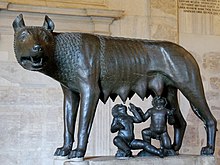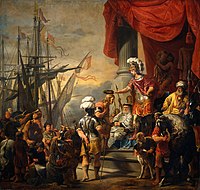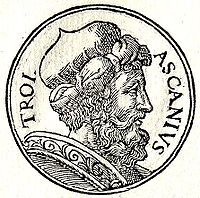Founding of Rome
The foundation of Rome is referred to by several legends, which were unified mainly by Virgil's Aeneid, bringing together different versions of some initiation rites in a coherent story of that time.
Lazio and central Italy
It is assumed, with some probability, that between centuries century X a. C. and VIII century B.C. C., Central Italy was populated by the two main groups into which the Italians were divided: the Osco-Umbrians and the Latins. Latium Vetus (the former territory of Lazio) was populated by Etruscans, Volsci, Sabines, Aequi, Rutulos and Ausonians. They came from different areas of central Italy, including Tuscany, Marche, and Liguria.
Between them, the Latins developed an organized society that was the main source of the Roman population. The Latins originally stayed in the Colli Albani (the Alban Mountains, in modern Castelli), some 30 to 80 km southeast of Capitoline Hill. Then they went down to the valleys, which offered better land for agriculture and livestock.
The immediate areas to the river were very favorable and also offered notable strategic resources: the river formed a natural border on one side, while the mountains provided a defensive shelter on the other. This position also gave the Latins control over the river, and its possible commercial and military traffic, from the natural vantage point on Tiber Island, the island situated opposite present-day Trastevere. Land traffic could also be controlled, since Rome was at the intersection of the main roads to the sea from Sabinia, to the southeast, and Etruria, to the northwest.
It is assumed that the development of the settlement began with different separate populations (borgate), located in the mountains, which were united to form Rome. Recent studies suggest that the Quirinal Hill was very important in ancient times. However, the first hill to be inhabited seems to have been the Palatine (which would confirm the legend), which is in the center of ancient Rome. Its three ridges (the minor mountains Cermalo or Germalo, Palatium and Velia) joined the three peaks of the Esquiline (Cispio, Fagutal and Opio), and then the towns on Mount Celio and Subura, between the mountains of Rione Moderna, Monty and Opium. Subsequently, the city grew to include the Aventine, Capitoline, Quirinal and Viminal mountains as well.
These mountains had expressive names: Mount Celio was also called Querquetulanus, due to the oaks (quercus), while the Fagutal (Fagutalis) was populated by beech forests (fagus) and the Viminal (Viminalis) by the osier (vimen) of willows. Recent discoveries reveal that the Germalus, on the northern part of the Palatium, was the site of a population from the IX century BCE. C. with circular or elliptical houses. It was protected by a rammed earth fence (perhaps reinforced with wood), and it is likely that this place was where Rome was actually founded.
The territory of this federation called pomerium enclosed the so-called Roma Quadrata (square). This would be extended with the inclusion of the Capitoline Hill and the Tiber Island when Rome became an oppidum, a fortified town. The Esquiline was still a satellite town. This would be included with the Serb expansions.
The celebrations of the septimontium ("of the seven mountains"), on December 11, were then considered in relation to the founding of the city. However, as April 21 is the only date on which all the legends agree, it has recently been argued that the septimontium probably celebrated the first federations between the mountain peoples. romans; in fact, a similar federation was celebrated by the Latins in Cave, a small town in the southeast of Rome, or on Monte Cavo in Castelli.
Foundation according to legend
Aeneas, Ascanius and Alba Longa
The legend about the Roman foundation tends to associate the nascent town with the most eminent entities of their time, in order to "demonstrate" that its great success also depends on its special origin, or to complete its reputation with first-class references. However, this story is a complete story, and the entire Roman tradition is based on it. There are several versions of this legend; the following is commonly considered to be the main one:
With the demigod hero Aeneas in command, the defeated surviving Trojans crossed the Mediterranean Sea to reach the shores of Latium. They arrived in an area probably between modern Anzio and Fiumicino, southwest of Rome. More commonly it is supposed that they arrived at Laurentum (or Laurento); other versions say that they arrived at Lavinium, a place named after Lavinia, the daughter of the Latino king.
Latino, wise king of the Latins, welcomed them, letting them reorganize their life in Latium. Her daughter Lavinia had been promised to Turno, the king of the Rutuli, but Latinus preferred to offer her to Aeneas; Turnus consequently declared war on him. The result was the death of Turnus and the capture of his people. Ascanius, also known as Iulos, son of Aeneas, founded Alba Longa and was the first in a long series of kings, among whom the best known are Procas and his sons Numitor and Amulius. According to Dionysius of Halicarnassus, the kings of Alba Longa were the direct link between Ascanio and Romulus, the founder of Rome.
The god Mars was walking along the bank of a river in the city of Alba Longa, there he saw a woman asleep on the bank and fell in love instantly. They had two sons named Romulus and Remus. Once the children of Rhea Silvia (last direct descendant of Aeneas) were born, the parents of the twins put them in a basket and they were transported by the river and reached the shores of a place. There they were saved by a wolf named Luperca who nursed them. Nearby lived a shepherd named Fáustulo and his wife Aca Larentia. The pastor found the babies, brought them to his house, and adopted them. When they became adults, the brothers were informed of their history, and the shepherd told them that they had not had them, so they returned to Alba Longa, killed Amulius, and freed their grandfather Numitor, restoring him to the throne.
Romulus and Remus set out to build a new city in the same place where they were found by the wolf. They decided that one would build the town while the other would help. So they began to ask the gods to find out who would direct it. Romulus went to the top of Palatine Hill and threw his spear into the mount to find the spot. The spear became the Corniolus, the sacred tree of Rome.
Romulus went to the top of Palatine Hill; Rowing to the top of the Aventine. Romulus was convinced that he had been selected by the gods, since he received the omen that flew over him were a circle of birds, so he threw his spear on the mountain to find the place; when he was on earth, the spear (which was made of wood) immediately became the Corniolus, the sacred tree of Rome.
For the foundation they followed the traditional rites of their time to found cities. With the help of a cow and a white bull, he used a plow to lay out the fence of the city. Remo jumped over the furrow, violating the wall, which was a kind of sacrilege, which was the first capital punishment of the homo sacer (which was the punishment for passing), since the wall was traced from the first moment to be inviolable. And according to tradition, Romulus killed him with the sword, so that the gods would not allow the wall to be violated again in the future.
Romulus was the first Roman king, and he reigned until he disappeared during a storm, carried off by his father Mars.
Adaptation of the legend
While the main body of the legend has remained more or less the same since its creation, some details have changed, mainly to bring together the slightly divergent versions and correct various points regarding time and geography. Also the old local legends were gradually elaborated to reach harmony with the main story. The effect of these interventions on the legend are considerably evident.
Aeneas, founder of Rome
One of the earliest versions (V century B.C.) is that of the Greek Hellanicus of Lesbos, and is generally reported along with Sigeo's version of Damastes. In this version, the founder of the town was Aeneas. These versions survived until 509 BC. C. (year considered in which the Roman Republic begins), when it was realized that, as there had been 7 Roman kings and Romulus was the first, there was a gap between the century VIII of the first kings and the XII century of the fall of Troy. So, since Romulo could not be Iulo's son, he only remained as a distant descendant. The time between Iulo and Rómulo was "filled" with the series of the kings of Alba Longa. Aeneas could have reached the shores of Lazio during the reign of Latino (king of the Latinos), in order to reach an agreement with local legends. So Mars had to be added in order to honor him, so Romulus became a descendant (on his father's side) of Mars, while on his mother's side Rhea Silvia was connected to Aeneas through the Alba Longa dynasty. The condemnation of the sons of Rhea Silvia is only one of several recollections of divine laws, of the religion that entered so deeply into Roman life.
Evander, Founder of Rome
Among the Italics, as reported in Hesiod's Theogony, the two brothers Agrio and Latino were the sons of Telegonus, son of Ulysses and the witch Circe, to whom Mount Circeo is dedicated, located to the south of the Lazio, where a cult was held in his honor and his cave was.
Among the Latins, it was said that Saturn had been replaced by his son Jove, so he came down to Earth and mixed with the Latins. Evander then led his people from Greece to Latium, where he built the city of Pallantheus, which was situated on a hill later called Palatine Hill. Then Hercules came to free these lands from the threat of the giant Cacus. Finally Aeneas arrived from Troy, after various adventures, and founded Rome. Notably in this version the Latins were not created or assisted by the gods, but the town was founded by Aeneas in the presence of these 'authorities'.
The date of the founding of Rome
During the Roman Republic, several dates were given for the founding of the city, all in the interval between 758 B.C. C. and 728 a. Finally, under the Roman Empire the date suggested by Atticus and Varro (753 BC) was agreed, but in the fasti capitolini the given year was 752. Although the years varied, all the versions agreed that the city was founded on April 21, a holy day dedicated to the sacred worship of Pales, goddess of shepherds; In her honor, Rome celebrated the parritta (or palilia).
Recent discoveries on the Capitoline Hill in Rome have provided the date of the founding of Rome. Most prominent among these is a series of defensive fortifications on the northern slopes of Capitoline Hill that can be dated to the mid-VIII century a. C., when the legend says that Romulus carved a furrow ( sulcus ) around the Capitoline Hill to delimit the perimeter ( pomerium ) of his new city. The remains of the wall and other evidence like this have been discovered by the excavations of Andrea Carandini.
The name of Rome
The town's name is generally considered to refer to Romulus, but there are other hypotheses. One of them refers to Rome, which would be the daughter of Aeneas or Evandro. An Etruscan origin can also be traced, which would point to the Etruscan gens Ruma, or to Rumon, the Etruscan name for the Tiber river. Recent studies seem to give preference to a root of Indo-European origin meaning "river"; Rome in that case would mean "the town on the river".
Rome is also called "city", and this name, which later in Latin would generically mean any other town, comes from "urvus", furrow made with a plow, here, by Romulo's.
On Capitoline Hill, on April 21 of each year, a special bell called the patarina rings at noon from the Campidoglio to commemorate the founding of Rome. On that occasion, the famous Gianicolo canyon remains silent, the only day of the year when it does not sound.
Contenido relacionado
James II of England
Zamora Province
Syphilis








